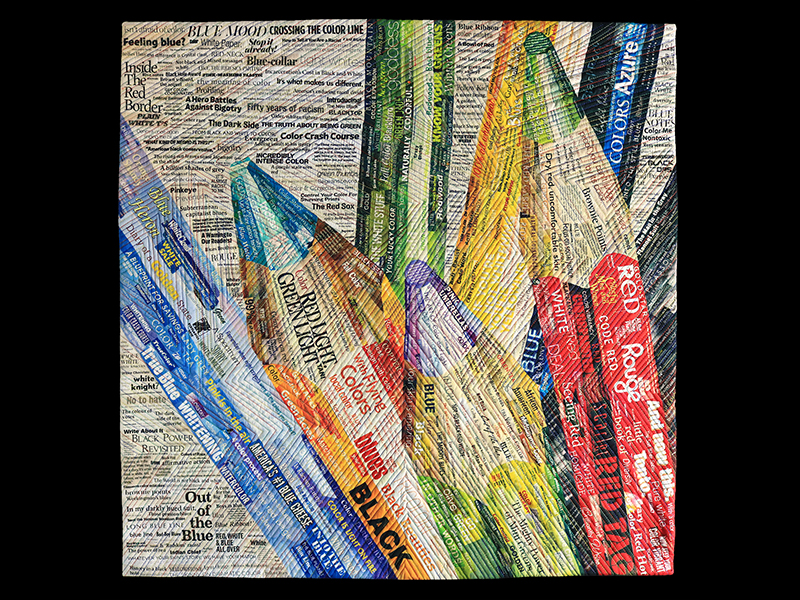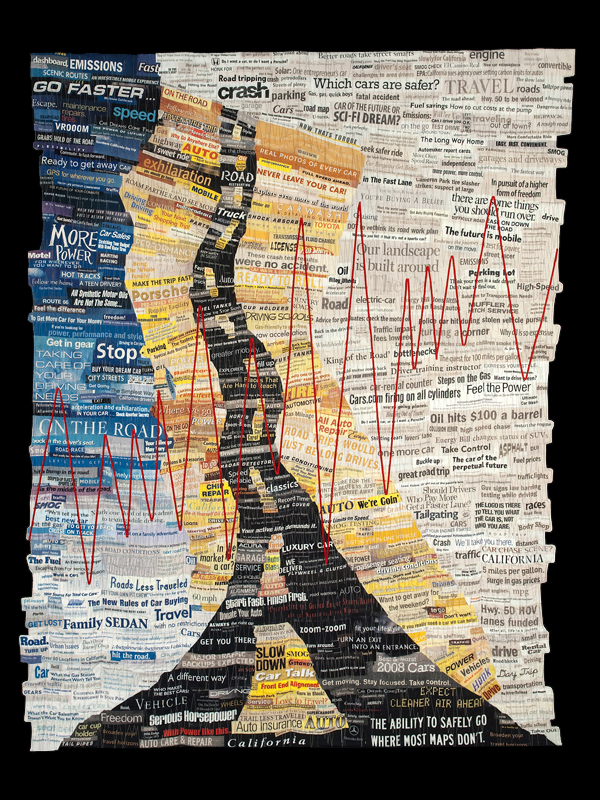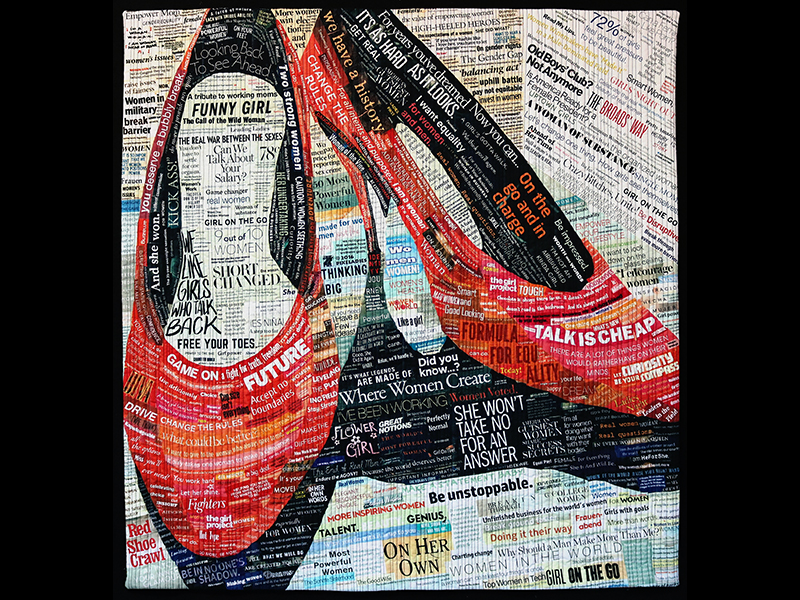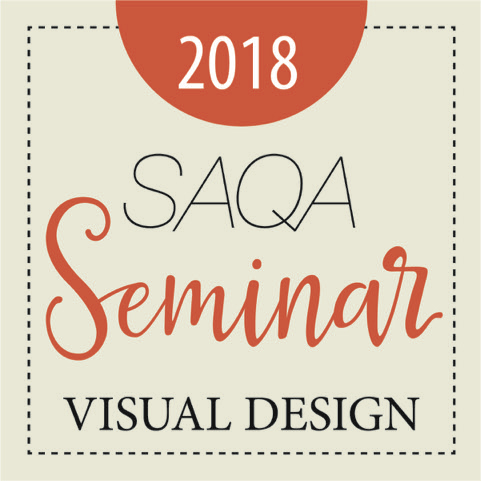SAQA Seminar - Unit 4
Artist Q&A with The Pixeladies (Deb Cashatt and Kris Sazaki)
Tell us about your artwork and artistic career.
Cloth, computer, collaboration – these three Cs are the essence of the Pixeladies’ art. They work in cloth because of its tactile and flexible nature. They have transferred some of their work process to the computer, merging the traditional textile world with the innovative nature of the digital. By feeding off of each other’s ideas and venturing off in new and fascinating directions, they have come to realize that art need not be an isolated endeavor. Through the collaborative process they draw out one another’s talents in surprising ways. Collaboration is sometimes challenging but amazingly stimulating and productive.

The Language of Color 9: Color Dissonance
If the Elements of Design are line, shape, color, value, texture, and space, which one (or two) do you focus on most in your work? Why?
Both: FYI, when we teach design, we define the basic elements as line, color, shape, and texture. We see value as part of color and space as being created by line and shape.
Kris: I want to say color because that’s usually the first thing I see, but in our work, we are constantly looking at value to determine if our collage will work out or not.
Deb: I guess in our current work, I try to focus on shape. Can we find a (workable) shape that adds to our message? Can we render the shape of the object so it looks somewhat 3 dimensional? To achieve that 3-d effect we concentrate on value.

Fault Line
What techniques and materials do you use to create the elements of design in your work?
We use Photoshop to create a template that we will collage with paper clippings. We then will manipulate color in the computer.
Are there certain steps in your design process when you think more about the elements of design than others?
Kris: We have to get the value right. Otherwise, we lose the object or portrait we are trying to collage. Line becomes critical when we are trying to decide how to quilt the piece.
Deb: Sometimes we create lines in the composition using text. Line is critical in our quilting, most of the time we focus on how not to have the line distract from the composition. I would like to work on how to make the quilting lines tell part of the story.
Is there a particular question you ask yourself or an idea that you keep in mind when you are focusing on the visual design of an art quilt?
Kris: Does the message fit the form?
Deb: I would say does the form fit the message. I guess that shows one of our divisions of labor. Kris usually comes up with the message and I usually come up with the form.
.jpg)
American Still Life: The Weight of the Nation
If the Principles of Design are pattern, rhythm, proportion, balance, unity and emphasis which one (or two) do you focus on most in your work? Why?
Kris: This is a tough question. I would tend toward balance, but that may be because we are currently working on a portrait and trying to plot out the quilting.
Deb: That is a hard one. I think proportion and emphasis. Because we use “found” text, sometimes the size of the words are too large in relation to the surrounding words. This puts an emphasis on the word and component of the shape/form. Sometimes we want this, other times it distracts from the overall composition.
How would you describe your process? What role does editing or revision play in your process?
Kris: We do a lot of editing and revision during the major steps of our process; they are critical to our process. Once we flesh out the idea, we work out the template, making several if not dozens of revisions. Once we have the collage in the computer, we perform more editing and color correction.
Deb: I would say we do a lot of “mental editing” in the beginning (before starting the collage), and at the end (before quilting). Before we start on the actual piece, we have to agree on the composition and message. At the end of the process, we have to agree on how to quilt the piece. I think this is one of the hardest parts for us. We will frequently rip out quilting to change thread color or type (hand or machine stitching can change the texture of the piece)
I will say that one of our most successful series (The Language of Color) started with words that had to do with color. Green with envy, yellow submarine, little black dress. Phrases like this were everywhere. We had collected hundreds of these color snippets before we could agree on a form (colored pencils) and a message (race).
Also, I think Kris left out the evidence for our proclivity for revision. When making the paper collage, we use repositionable glue sticks.
We also have 2 finished pieces that neither of us are satisfied with. We’ve already completely taken apart one, and we’re trying to figure out a way to salvage the other.

Walk a Mile in Her Shoes 2: 78¢ on the Dollar
How do you evaluate or critique your work?
Kris: Well, there are two of us so we are constantly critiquing what the other one does! Seriously, we constantly have a back and forth through the various stages of the process. We have been known to leave pieces aside for a long time until we can come to a consensus on how we should continue.
Deb: And because we have to try to persuade the other, we have to be able to communicate our personal vision. This is where the elements and principles come into play. They are terms we can use to help communicate ideas or differences.
Do you use the traditional elements and principles of design as a way to measure if a piece works of not? What other ways do you evaluate the visual design of a piece?
Kris: Yes, we do. Unfortunately, we don’t always hone in on the right element(s) or principle(s) until we are sitting with a finished piece we’re unhappy with. But, eventually seeing why a piece works or doesn’t is all part of the artistic journey, no?
Deb: Yeah. Especially when it doesn’t work.
About the Artists
![]() Deb Cashatt and Kris Sazaki have been collaborating as the Pixeladies since 2003. One of the hallmarks of their work is the inclusion of text, which they view not only as message but aesthetic vision. Their work is in private collections and has been exhibited and published internationally.
Deb Cashatt and Kris Sazaki have been collaborating as the Pixeladies since 2003. One of the hallmarks of their work is the inclusion of text, which they view not only as message but aesthetic vision. Their work is in private collections and has been exhibited and published internationally.
The Pixeladies also teach classes on using Photoshop for fiber artists including Digital Designing.
« Return to SAQA Seminar main page

